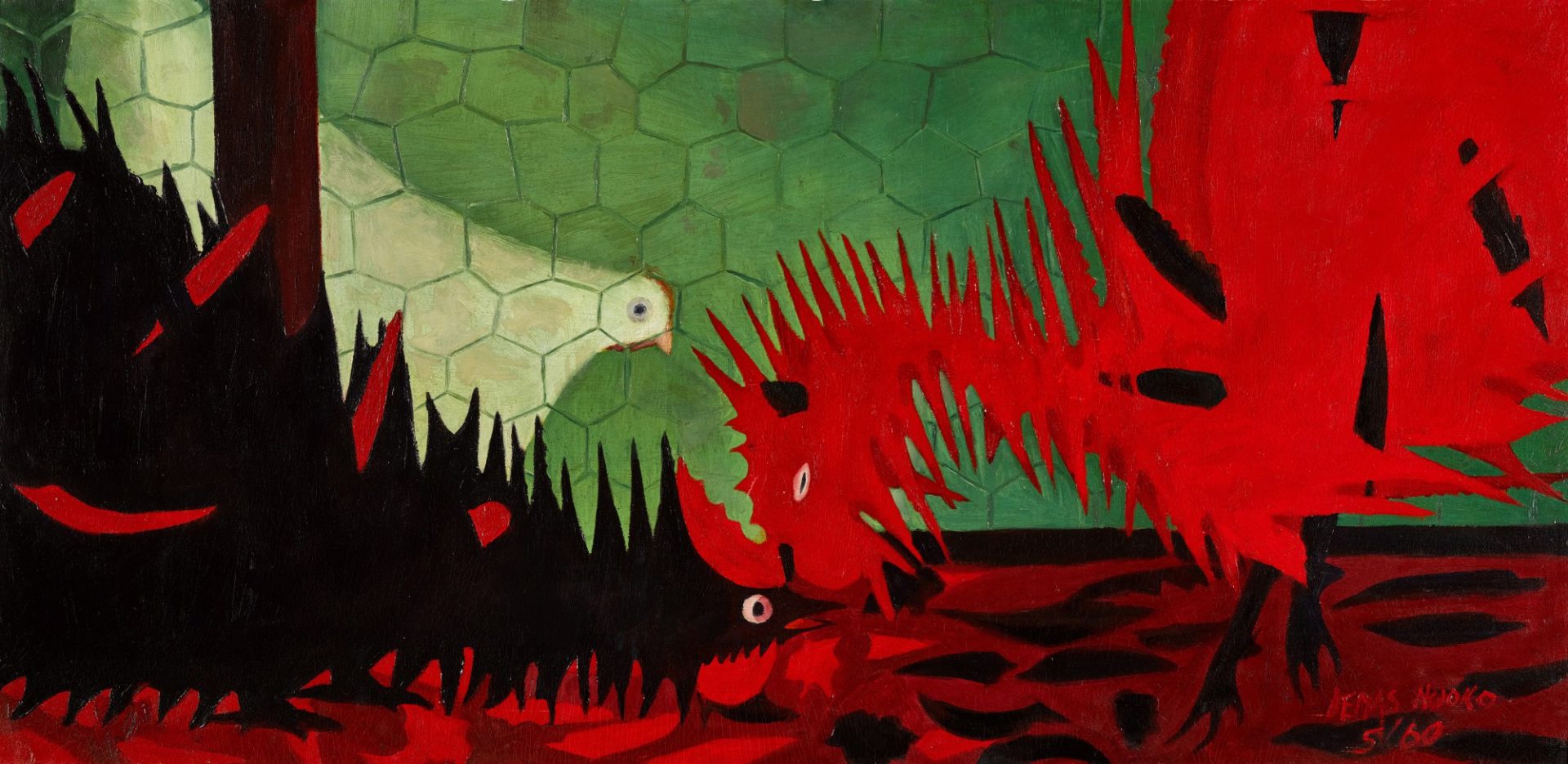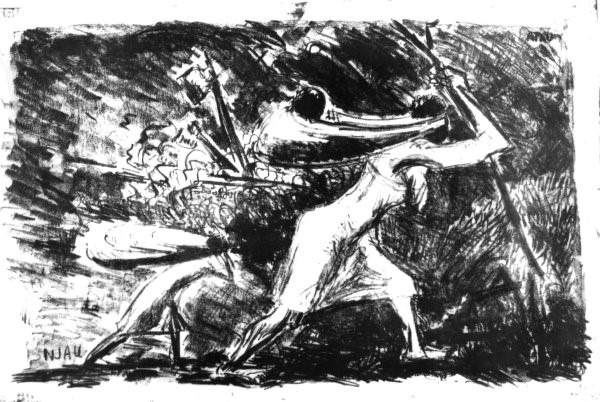At the Carl Van Vechten Gallery at Fisk University
African Modernism in America: Fisk University’s Historic Role in African Art
Two roosters are frozen in an almost comically surreal cockfight. But their feathers, soaked in brilliant red blood, and the darker blood splotches against a black background belie any humor. Behind the combatants and chain link fencing, the green background frames an expressionless white hen looking on, as if waiting for the deadly foolishness to end.
“Folly” by noted painter and architect, Demas Nwoko, appeared in 1960, the same year that the Republic of Nigeria officially hoisted its new green and white flag above the then-capital of Lagos. The use of the flag’s colors has become a recurring signature of Nwoko’s style. This oil on board painting is part of a wonderfully varied exhibit of art by Africans across the spectrum of the continent during the mid-twentieth century Modernist period.

African Modernism in America, 1947–1967*, housed at the Carl Van Vechten Gallery at Fisk University, culminates a five-year project. Curators Perrin Lathrop, a Princeton doctoral candidate and the Warhol Foundation Curatorial Fellow at Fisk University Galleries; Dr. Nikoo Paydar, former Associate Curator for Fisk Galleries; and Jamaal Sheats, Director and Curator of Galleries at Fisk envisioned an acknowledgment of African Modernism with a twist, women would receive equal treatment.
Added to that warp thread of openness, the exhibit ties weft threads of different media, techniques, and styles: murals, book covers, painting, collage, lithograph, oil, watercolor, photographs, expressionism, realism, impressionism, primitivism. All these threads would be woven together in a thematic kente cloth of fundamental Africanness on a loom of Americanness: “The show reveals a transcontinental network of artists, curators, and scholars that challenged assumptions about African art in the United States.” Many of the featured artists either traveled to the US to study, had their works displayed and promoted here, or invited African American artists to Africa.

One of the exhibit’s strengths is the inclusion of a variety of media and artistic functions, including a photo of Uche Okeke’s mural decorating the walls of Mbari Artists and Writers Club in Ibadan, Nigeria, where highly respected writers like Nobel Laureate Wole Soyinka and International Booker Prize winner Chinua Achebe launched their careers. In a glass-encased display of books, guests can observe Guyanese illustrator Denis Williams’ cover art for the 1963 edition of Soyinka’s Three Plays. The Mbari club also nurtured local talent by inviting Americans like Langston Hughes to share in artistic exchange with its members, a fundamental theme for this exhibit.
Although some pieces in this exhibit are borrowed, most come from Fisk’s own notable collection enhanced by gifts from the Harmon Foundation. Tanzanian Elimo Njau’s lithograph, “The Load and the Hoe,” depicts Kikuyu women working in the fields in the midst of the chaos of the Mau Mau wars. The wide variety of strokes—charcoal brushing, jabs, and smears—swirl around two women, deepening like an impending thunderstorm as their babies swing wildly from slings on their backs while the women work with a clear sense of urgency. Clara Etso Ugbodaga-Ngu’s oil on canvas “Beggars” from nearly a decade later, depicts a calmer atmosphere with three people singing proudly together.
One of the most startling works is René Bokoko’s untitled gouache on canvas work from 1960. As part of his Imaginative & Vivid African Human series, this Congolese artist specializes in bright colors and images full of vitality. Against the vivid blue scrim of this painting are segmented ebony figures engaged in a variety of traditional activities.

In true African American style, the entire event embraced improvisation, riffing off a basic idea. Walking into the gallery office, the first sight is Fisk galleries coordinator, Lakesha Moore, braiding the hair of featured artist, her elder, Ndidi Dike. In the gallery itself, the exhibit is set out in stages, the first three chronicling the institutions that promoted African art in the US, collaborative networks that formed in the Sixties, the specific connections between African and African American artists. In all these stages, and the last, Fisk itself has played a vital role.
The last stage, the works of art themselves, begins with a multimedia collage commissioned from Ms. Dike, short-term artist-in-residence at Fisk, the only living artist on display. Her three-panel work “Politics of Selection” honors Nigeria’s current twenty-naira bill, a bill that honors the work of ceramicist Ladi Kwali, an artist who spent some time in residence at Fisk. Granted, Kwali is on the back of the bill, with a heroic general on the front, but still…
Then in a gesture of genius in presentation, a small table placed at the base of the second panel, holds Harmon Foundation co-director Evelyn S. Brown’s book on African Modernists, sharing space with one of Kwali’s pots, a well-proportioned earthenware vase, rounded as an expectant mother, its glaze glowing with health, resting comfortably on a stand above a scattering of warm red soil. To have a bit of Mother Earth as part of this environment is a touch that lingers long after the wine, music, and social chatter fade into the background.
For such big ideas, the exhibit is relatively small, manageable for neophyte museum-goers, with works that will hold the attention of veteran art lovers. The exhibit opened on October 6, 2022, for an indefinite stay. The Carl Van Vechten Gallery is located on the Fisk University Campus at 1000 17th Avenue North @ Jackson Street. For more information, see www.fiskuniversitygalleries.org, call 615-329-8720, or email [email protected].
*African Modernism in America is co-curated by Perrin Lanthrop, Nikoo Paydar, and Jamaal Sheats. This exhibition is co-organized by the American Federation of Arts and Fisk University Galleries. Major support for the exhibition is provided by Monique Schoen Warshaw. Additional support is provided by grants from the Marlene and Spencer Hays Foundation, the Mellon Foundation and the Andy Warhol Foundation for the Visual Arts. This project is supported in part by the National Endowment for the Arts.
- About the Author
- Latest Posts
Y Kendall is a Stanford-educated musicologist, specializing in dance history who recently earned an MFA in Creative Nonfiction at Columbia University, studying nonfiction writing with Ben Ratliff and Margo Jefferson. Kendall’s diverse works have been published in Alchemy: Journal of Translation, Columbia Journal, Mitos Magazín, The Hunger Mountain Review, and The Salt Collective, among others. Born and raised in Tennessee, Kendall now lives near Nashville, freelancing as a flutist and writer, while caregiving for relatives.



